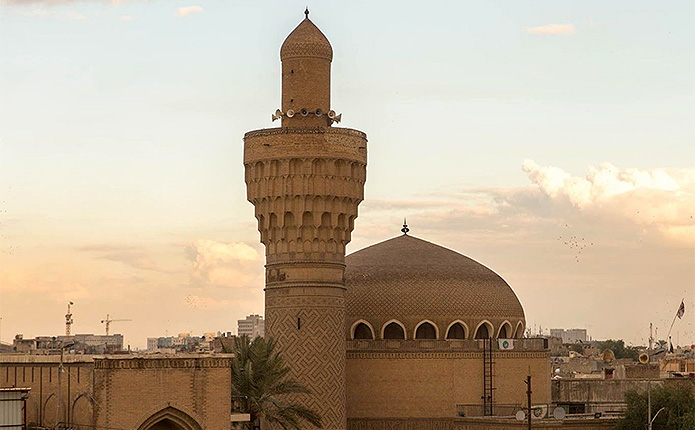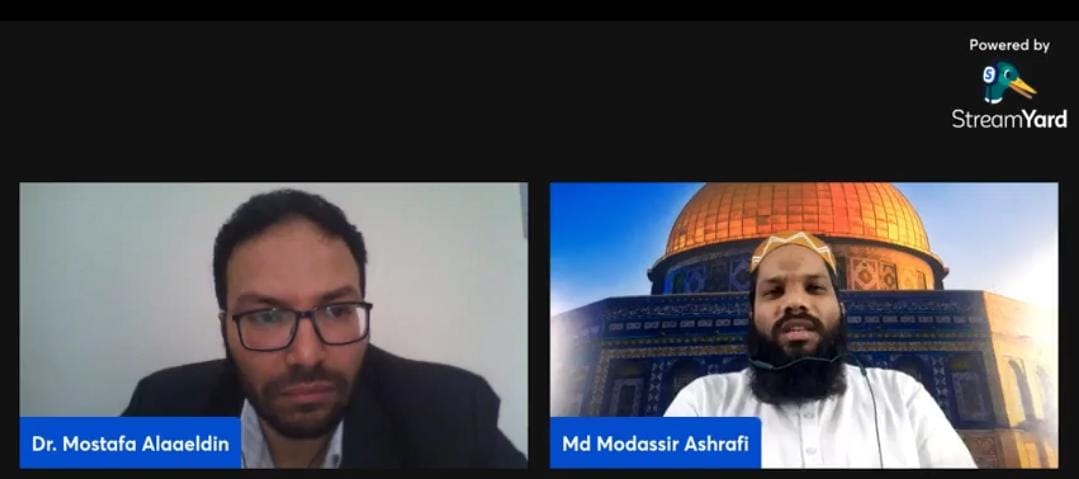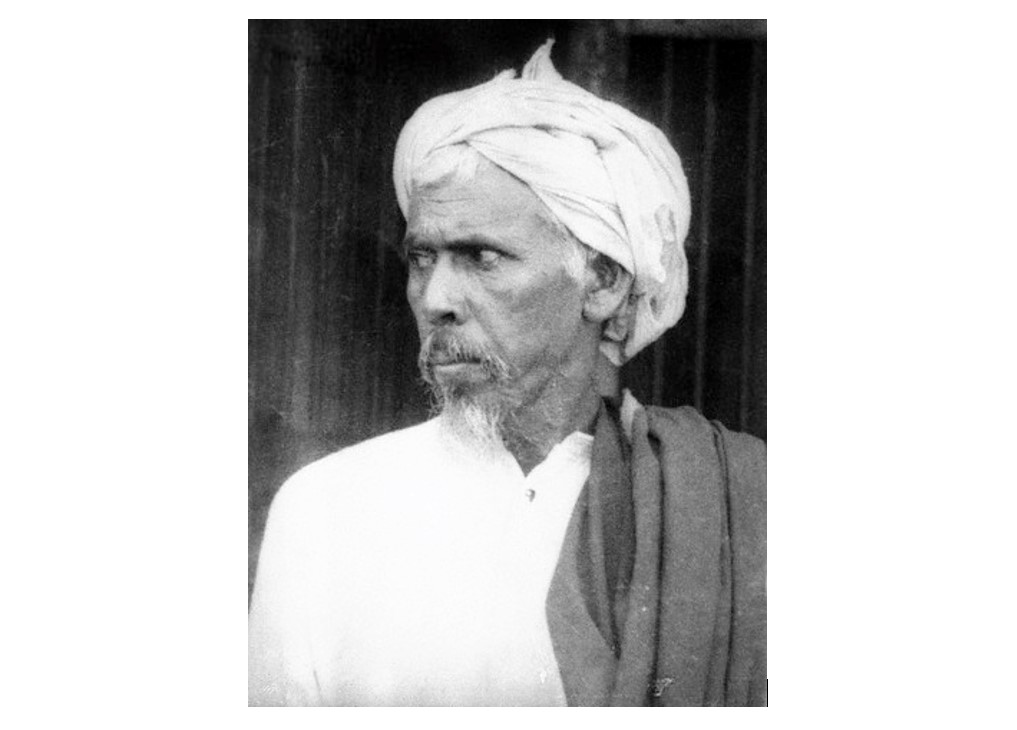Dr. Maysoon Muhi Hila
Department of Architecture Engineering, Samarra University, Iraq
ABSTRACT
The concept of (architectural heritage) is more concepts interesting by The scientific community in Iraq and has long been a relatively dating its beginnings to the early sixties of the twentieth century, and coincides with the establishment of the Iraqi school of architecture in fifties, and since that time has increased awareness of the importance of architectural heritage as one of the ingredients for a sense of identity and continuity of civilization. Islamic architecture in Iraq Characterized on mosques as a field essential to reverse the manifestations , so it was a great place for social effectiveness as minarets emerged on the difference others before and there were multiple types of contracts starting from the semi-spire to full eara to half of the ring , and then appeared cornice, a trim architectural resembling beehives used in mosques in which layers are paved with two purposes ,Structural and decorative at the same time ,Column decorated with a crown is also used as a structural and decorative e marked Islamic column Brchagueth measure of Greek columns with Romania decorated with crown Neck long and sometimes busy square Page( muqarnas) or square gang Adorned with magnificent geometric decoration made, with forms that are based( Alarbisk) the characteristics of the traditional architecture of the Iraqi use of domes that many Use in mosques, shrines, it has been domes in the first Covenant and even The end of the eleventh century AD a small, confined spaces used to cover the front of the (mihrab) then spread use of shrines and hired the first command to work this angle to facilitate the transition from the box to the appraiser decades, the elements of traditional architecture concentrated as follows :
- Decorative elements: The plant motifs are of the most prominent manifestations Explain away the Arab-Muslim artist for simulation of nature and transfer Literally, there is almost identifies, And leaves only lines curved or curled connection with some live.
- Engineering elements taken geometric particularly important in Arab-Islamic architecture in general, and enjoyed a unique personality unmatched.
- To bring more beauty that corresponds to the presence of unlimited
Keywords : Decorative Elements, Architectural Elements, Islamic Architecture Properties
I. INTRODUCTION
Islamic cities have witnessed, since the emergence of the first mosque in Islam (the Prophet’s Mosque) in Medina, a significant qualitative development, especially after taking the country to widen the scope of Islamic and join the nations and peoples of ancient civilizations to Islam. All this has led to supplement Islamic architecture with data elements and new vocabulary contributed, through the stages, in pushing the development of arts and methods of architecture in the Islamic world to high levels of artistic and aesthetic and heritage aspects.
Islam during half a century of its launch, entered the oldest centers of human civilization, starting from Mesopotamia, Egypt, Byzantium, where Greek and Roman heritage, even to Syria, North Africa and Spain also. This widespread, is an important historic and cultural transformation in human life We have absorbed the arts of Islamic architecture that arose and appeared in less than a century after the migration, the tributaries of these civilizations, so the Arab Muslim conquerors aesthetic values of art that ancient civilizations affected, Vatjht their care to pay attention to Bamarthm and decorated with different types of elements and vocabulary of architectural engineering ones and decorative, thus winning the aesthetic appearance
commensurate with the importance of the role played by these cities.
II. METHODS AND MATERIAL
Heritage Buildings
UNESCO definition of historical and heritage areas as “buildings and squares and spaces range includes archaeological sites that make up the human settlers in an urban or rural environment, and recognizes the value of the archaeological or architectural or historic or aesthetic, social or cultural” . Studies and reports of the organizations involved in heritage and heritage buildings indicate that the presence of these buildings, because of urbanization and change within the urban and urban cities Ocean, has become within two classes, made up some of the named buildings heritage of individual or individual and heritage buildings within the urban fabric. heritage in general and especially in Iraq have been built within the fabric of builders compact formed from shops cities and markets where open up the blocks on the spaces of courtyards and alleys only traditional Alvadwat, but this traditional fabric that may be offered in all cities, especially Baghdad to changes on the urban level of open streets and the demolition of parts it, in addition to the collapse of other parts resulting in some of the buildings be kept separate (Ktlaa) from the previous surroundings, and that some of them fired the buildings individual name, and there is another type of buildings individual are those buildings that were built since the thirties of the twentieth century in the neighborhoods planned in that era characterized by straight streets and absorbed for the passage of cars, and the designs of buildings thirties and periods subsequent facing out, that is, they lost recipe stacking mass in the traditional fabric, that such buildings and classified heritage also feature from the surrounding context By the term. (Figure 1-1).
The Basic Elements of Islamic Architecture In Iraq
- Stalactites is Considered the most prominent features of Islamic architectural decoration, and most splendor. It is a decoration composed of prominent apses matrix covering the areas of transition between the horizontal and vertical surfaces. It consists of a real building or implement additions of gypsum or other materials. Stalactites and used in particular in the areas of transition in domes and gates and down the balconies
of minarets and others. It is the most beautiful stalactites are visible phenomenon stalactites Abbasid Palace (school Sharabia) in Baghdad, as well as stalactites shrines in Iraq.
- Islamic tiles (porcelain) and their uses to decorate Islamic buildings is one of the arts that Muslims invented and developed over many centuries. It is the oldest those found in the city of Samarra in Iraq, which date back to the ninth century and includes rare artistic effects found in some mosques and palaces palace Jawasaq al Khaqani Islamic tiles.
- Wooden decorations and a private( mashrabiyya) is one of the arts of Islamic architecture features. Mashrabiyya has spread ornate wooden balconies, a prominent construction in many Muslim cities. And characterized by the beauty of wood carvings, a testament to the beauty of Islamic architecture and progress during the periods of its history, cultural heritage.
- The most important cultural achievements of Islamic architecture is the confirmation of employment of local building materials in Islamic countries Kaltabouk (brick) and materials decorative Kalplat faience, mosaic, wood, etc., and use a great artistic way in the construction of buildings and decorated even fit the environmental and climatic conditions and in line with the cultural and social life of each region.
- The forms are made of bricks and decorative units or sections make up, in the case of paved engineered, forms and geometric motifs and wonderful vegetable. As well as some of the writings and types of lines and especially beautiful Kufic script that was used frequently in the form of decorations for writing Quranic verses stones. An example of Islamic buildings, famous for the art of decoration beautiful brick, Mustansiriya school built in (631 AH / 1234 m.), Is of the most famous buildings that exist today in Baghdad since the Abbasid period .
- The stucco decoration in decorating the walls were found in the ruins of the Abbasid buildings in Samarra, and a private engineering and plant them. The section in the form of bunches of grapes and leaves.
- Wide iwan which topped domes surrounded dish (uncovered) Yard,. And appear in buildings with
arcades and metaphors in Iraq, the great and the lobby encased contracts semi-circular, and in particular in the Abbasid Caliph Palace Mutasim in Samarra, which was built a year (221 AH / 836 AD.), As well as Ukhaydir Palace near Karbala, which was established in the chest first of Islam
- There is also another key element of architectural arts is one of the distinctive elements of Islamic architecture taking, and replaced by the problem of transition from the building with a square base to the dome that topped a half circular. Where it used curves corner a concave triangles of stone or brick plaster
Islamic Architectural Heritage Properties in Iraq
Arab Muslims benefited from the Arts peoples architecture, which entered Islam from other arts what they found appropriate Islamic civilization and in accordance with the traditions and customs, and was inspired by Muslim artists from the ancient civilizations of Mesopotamia arts high massive exterior walls decorated with various decoration of buildings, as well as some architectural forms Kalzkorat Babylonian, which left their mark on the minarets in the Abbasid era, Kmiznh Mutawakkil Mosque (twisted Samarra) in Iraq, and the minaret of Ibn Tulun Mosque in Cairo, and the minaret of the Mosque of Abu DLF also in Samarra.
The highlight of the afternoon in the Arts groves Islamic cities is the formation of the new architectural elements, innovation and technical vocabulary and expressions.
III. RESULTS AND DISCUSSION
There are architects, another large-iwan which topped domes surrounded a la carte (open) Yard, in buildings with arcades and metaphors as is the case in Iraq
Most of the buildings constructed at the beginning of the Abbasid period elements and vocabulary Arts buildings Sasanian constructed in Iraq during the period of Sasanian rule have been affected, the great Kalaiwan, the grand lobby encased contracts semi-circular, and in particular in the Abbasid Caliph Palace Mutasim in Samarra, which was built a year (221 AH / 836 AD. ) as well as (Ukhaydir Palace) near Karbala, which was established in early period of Islam. In addition to the advantage of the architectural style that was prevalent in the groves of Mesopotamia.There is also another key element of architectural arts is one of the distinctive elements of Islamic architecture taken from the Sassanid
architecture, and has spread in many Muslim countries, and solved the problem by moving from the building with a square base to the dome that topped a half circular. Where used curves corner a concave triangles of stone or brick plaster.
Figure 1. Abbasid palace, represents a model of heritage buildings for individual urban fabric in Iraq
IV. CONCLUSION
Although a conclusion may review the main points of the paper, do not replicate the abstract as the conclusion. A conclusion might elaborate on the importance of the work or suggest applications and extensions. Authors are strongly encouraged not to call out multiple figures or tables in the conclusion these should be referenced in the body of the paper.
V. REFERENCES
[1]. Al Jabri, Ali Hussein, (philosophical dialogue between civilization and culture of the Middle Greece), a series of books, the number of 12.1991.
[2]. Abu Obeida, Hassan, (the history of the ancient buildings), house lights, edition 1.2001.
[3]. Shuaibi, Ahmed, (the ancient buildings and rehabilitation), Beirut for publication and distribution 2.2005
[4]. Chaderchi, raised, (Problematic heritage and contemporary), Freedom House printing, 1.1999.
[5]. Saudi ,talb, (the Arab and Islamic palaces in Iraq), House of Cultural Affairs, Baghdad ,8, 2001.
[6]. Rezouki, Dr. gadha Moses, (privacy in architecture, analytical study of the architectural heritage and employed in contemporary Iraqi Architecture), unpublished doctoral thesis, Department of Architecture, University of Baghdad.1987
[7]. Fathi, Ihsan, “a symposium architectural heritage and contemporaryArab architecture, cultural building), No. 5.1983.
[8]. Al Jabri, Ali Hussein, (philosophical dialogue between civilization and culture of the Middle Greece), a series of books, the number of 12.1991.
[9]. Abu Obeida, Hassan, (the history of the ancient buildings), house lights, edition 1.2001.
[10]. Shuaibi, Ahmed, (the ancient buildings and rehabilitation), Beirut for publication and distribution 2.2005
[11]. Chaderchi, raised, (Problematic heritage and contemporary), Freedom House printing, 1.1999.
[12]. Saudi ,talb, (the Arab and Islamic palaces in Iraq), House of Cultural Affairs, Baghdad ,8, 2001.
[13]. Rezouki, Dr. gadha Moses, (privacy in architecture, analytical study of the architectural heritage and employed in contemporary Iraqi Architecture), unpublished doctoral thesis, Department of Architecture, University of Baghdad.1987.
[14]. Rezouki, D.gadh Moses, (creativity in architecture), research publication, Journal of Engineering, Department of Architecture,
University of Baghdad.2006
[15]. Abdel-Wahab, Jinan, (to preserve the architectural heritage in Iraq), unpublished Master Thesis, Department of Architecture, University of Baghdad, 1989.
[16]. Ali, Saleh al-Ahmad and a group of authors (Iraq in history), Freedom House printing .1983
[17]. Ali, Saleh al-Ahmad, (Iraq architectural landmarks), House of Cultural Affairs for printing, Baghdad.1989..
[18]. Baqer, Taha, Abdul Aziz (Research Methods in History and Archaeology), the Ministry of Higher Education and Scientific Research, National Library Foundation, the University of Mosul 0.1980.
[19]. Gabriel, Jinan Khmu, ( preservation of archaeological sites and revived purposes Alsaahbh), unpublished Master Thesis, Department of Architecture, University of Baghdad, 1986.
[20]. Abdel-Wahab, Mohamed Fahmy, (The scientific theory in archaeological Arts and Techniques and materials for restoration modern field), Cairo.1985.
[21]. Abdullah, D.maaz and Ghalib, and Dr. Ali Bakr, O.d.mamed, determine the materials used in the
synthesis of archaeological and maintenance of the building to be restored, and the Ministry of Culture-the Egyptian Antiquities Authority, 1991..
[22]. Aluqili, D.maysoon Muhi,( Rehabilitation and modernization of facilities), research published in the Journal of Engineering and Technology, University of Technology folder.26., No. 12.2008.
[23]. Mohammed, Ghazi Recep,( Arabic architecture in the Islamic eara in Iraq), Dar Ibn Al Atheer for printing and publishing, the University of Mosul,.1989.
(This Report is first published in International Journal of Scientific Research in Civil Engineering)




